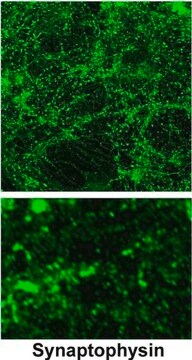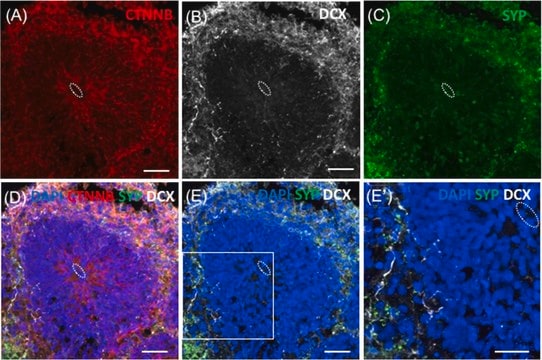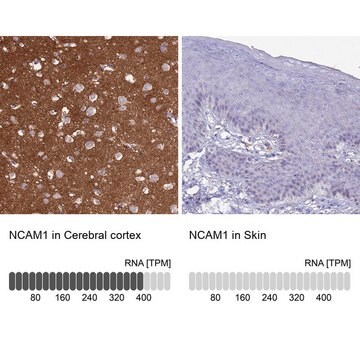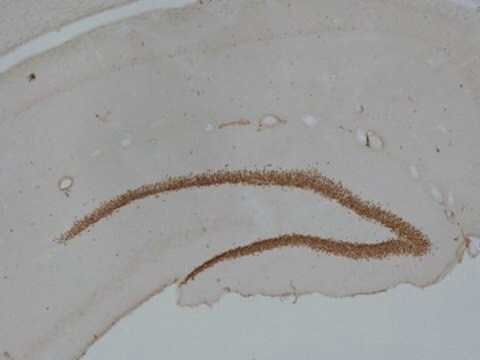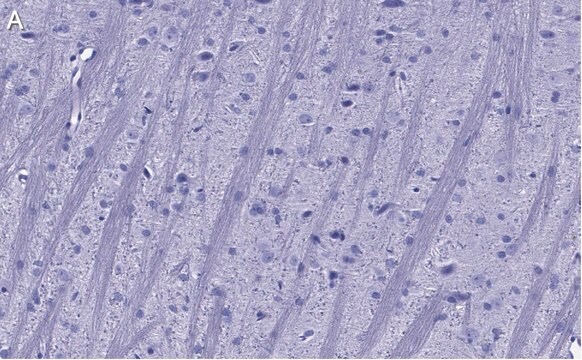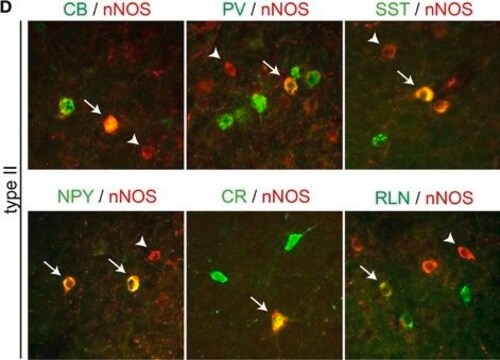MAB5258
Anti-Synaptophysin Antibody, clone SY38
clone SY38, Chemicon®, from mouse
Synonym(e):
synaptophysin, Synaptophysin
About This Item
Empfohlene Produkte
Biologische Quelle
mouse
Qualitätsniveau
Antikörperform
purified immunoglobulin
Antikörper-Produkttyp
primary antibodies
Klon
SY38, monoclonal
Speziesreaktivität
bovine, rat, avian, fish, mouse, human
Hersteller/Markenname
Chemicon®
Methode(n)
flow cytometry: suitable
immunocytochemistry: suitable
immunohistochemistry: suitable
western blot: suitable
Isotyp
IgG1κ
NCBI-Hinterlegungsnummer
UniProt-Hinterlegungsnummer
Versandbedingung
wet ice
Posttranslationale Modifikation Target
unmodified
Angaben zum Gen
human ... SYP(6855)
Verwandte Kategorien
Allgemeine Beschreibung
Spezifität
Immunogen
Anwendung
Neurowissenschaft
Synapsen & Synapsenbiologie
A previous lot of this antibody was used in Flow Cytometry.
Western Blot:
(Provoda, 2000) Reacts with a 38 kDa transmembrane glycoprotein
Immunohistochemistry:
For relatively cytoplasm-rich neuroendocrinic tumors a final concentration of 1 µg/mL is recommended. Concerning cytoplasm deficient tumors a concentration of 2 µg/mL should be used. Ideal frozen sections (4-5 mm) are obtained from shock-frozen tissue samples. The frozen sections are air-dried and then fixed with acetone for 5-10 min at -20°C. Excess acetone is allowed to evaporate at room temperature. Material fixed in alcohol or formalin and embedded in paraffin can also be used.
It is advantageous to block unspecific binding sites by overlaying the sections with fetal calf serum for 20-30 min at room temperature. Excess of fetal calf serum is removed by decanting before application of the anti-body solution.
Cytocentrifuge preparations of single cells or cell smears are also fixed in acetone. These preparations should but should be followed directly by antibody treatment.
Optimal working dilutions must be determined by end user.
Qualität
Western Blot Analysis:
1:1000 dilution of this lot detected synaptophysin on 10 μg of mouse brain lysates.
Zielbeschreibung
Verlinkung
Physikalische Form
Lagerung und Haltbarkeit
Hinweis zur Analyse
Positive Control: Pancreas tissue
Negative Control: Normal mouse serum
Rat hippocampus tissue, mouse brain lysate.
Sonstige Hinweise
Rechtliche Hinweise
Haftungsausschluss
Sie haben nicht das passende Produkt gefunden?
Probieren Sie unser Produkt-Auswahlhilfe. aus.
Empfehlung
Lagerklassenschlüssel
10 - Combustible liquids
WGK
WGK 2
Flammpunkt (°F)
Not applicable
Flammpunkt (°C)
Not applicable
Analysenzertifikate (COA)
Suchen Sie nach Analysenzertifikate (COA), indem Sie die Lot-/Chargennummer des Produkts eingeben. Lot- und Chargennummern sind auf dem Produktetikett hinter den Wörtern ‘Lot’ oder ‘Batch’ (Lot oder Charge) zu finden.
Besitzen Sie dieses Produkt bereits?
In der Dokumentenbibliothek finden Sie die Dokumentation zu den Produkten, die Sie kürzlich erworben haben.
Unser Team von Wissenschaftlern verfügt über Erfahrung in allen Forschungsbereichen einschließlich Life Science, Materialwissenschaften, chemischer Synthese, Chromatographie, Analytik und vielen mehr..
Setzen Sie sich mit dem technischen Dienst in Verbindung.

